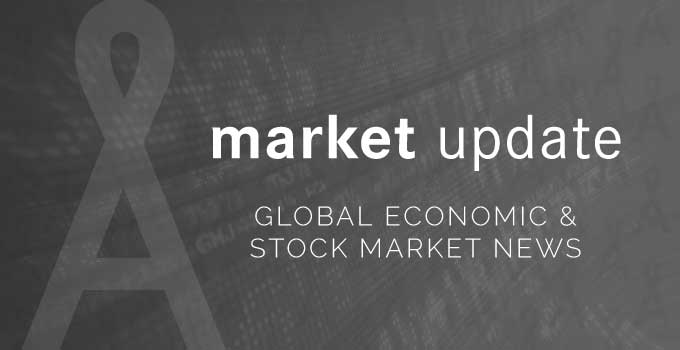
The Evolution of our Investment Offering
14/08/2019
Value of Advice – Exclusive interview with Jodie Hampshire CEO of Russell Investments
29/08/2019 Markets enjoyed a short-lived reprieve from the US-China trade conflict in July, but economic data points to a further slowing in the global economy. The US Federal Reserve’s recent rate cut appears justified given the re-emergence of trade tensions, with the US administration threatening 10% tariffs on the remaining $300 billion of Chinese goods. The US Fed has finally completed one of the most significant policy reversals in recent history. After lifting the funds rate towards 2.50% in late 2018 and signalling that there was some way to go with tightening (the FOMC dot plot pointed to a peak of 3.40% in 2021), July’s FOMC meeting saw members vote to lower the funds rate to a range of 2.00–2.25%. The pivot in policy over the past six to nine months has been in response to a combination of a slowing US economy, weaker global growth, uncertainties associated with the ongoing trade war, and consistent undershooting in inflation. At a hearing by the US House Committee on Financial Services, Powell said the Fed was prepared to “act as appropriate” to prop up economic expansion and support inflation. In terms of data, the US ISM manufacturing index declined to 51.2 in July from 51.7—the lowest reading since August 2016—while the new orders component rose only modestly to 50.8 from a flat 50.0, while the service sector ISM also declined to 53.7 from 55.1. CEO confidence levels have declined for the past five quarters while capex intentions have dropped to their lowest level since early 2017, although these are from elevated levels. Core CPI inflation ticked up a little to an annual 2.1% but the core PCE price index is only 1.6%, and the trimmed mean measures from the Dallas Fed are around 2.0%. The IFO Institute’s leading index showed that the mood among managers has weakened to its lowest level in nearly five years. The IHS Markit Global Business Outlook fell to its lowest level since 2012 in June, with new orders weakening sharply and business optimism at the lowest level on record. The survey sees the trade war causing a marked fall in optimism among US and Chinese companies. French 10-year bonds joined German bonds to yield a negative rate of return, reflecting expectations of slowing growth and prompting ECB president Draghi to reiterate that the central bank had “considerable headroom” to seek to stimulate the economy in the face of threats to growth, which include tensions over global trade. Core inflation in the Eurozone fell to 0.9% year-on-year in July from 1.1% and remains in the 0.8–1.2% range that has prevailed since early 2017. The Markit surveys suggest it is more likely to ease than rise, at least in the near term. Unemployment in the euro area continues to fall, dropping to 7.5% in June from 7.6%. The rate in each of the main economies is falling on a sustained basis in Germany unemployment is at its lowest level since 1990. In the UK Boris Johnson was handed the prime ministership by his party and will begin negotiations with the EU, calling on Brussels to drop the controversial Irish backstop from the withdrawal agreement. Chinese data over the past month has been mixed but generally in line with expectations. GDP growth in the June quarter slowed to 6.2%—the lowest level since 1992— and the July manufacturing PMI readings are both holding below the critical 50 level, while the service sector PMI fell to 53.7 from 54.2. Industrial production lifted to 6.3% year-on-year in June from 5.0%, and retail sales growth jumped to 9.8% from 8.6%. A surge in auto sales ahead of a change to emission standards underpinned the improvement. Indeed, consumption spending and the service sector is becoming an increasingly important driver of Chinese growth. From less than half of GDP in 2011, consumption spending is now 54% of GDP while accounting for almost two thirds of growth in 2018 and tax cuts earlier in the year have helped shield the economy from the impact of the trade war. Chinese exports recorded growth of 3.3% year-on-year in July, firmly beating expectations for a contraction, giving investors hope that the economy may prove resilient to the trade conflict. Money supply growth and the level of outstanding loans and total social financing (total credit) suggests the authorities have attempted to support the economy through monetary stimulus but not anywhere near the scale of previous stimulus phases. The Jibun Bank of Japan Composite PMI paints a picture of continued softness in the manufacturing sector and resilience in the service sector. The surveys are suggesting growth in the June quarter of an annualised rate of around 0.3%, down from the 2.1% seen in the March quarter. The slowdown reflects subdued domestic consumption and struggling exports. On a trend basis exports are falling at around a 5.0% rate so far this year, reflecting the slowdown in China and Europe and the ongoing trade war. Consistent with the Composite PMI, the recent BOJ’s Tankan survey for large manufacturers fell to its lowest level since 2016, but the service sector appears to be holding firm. Consumer confidence continues to decline from its recent peak in late 2017. Retail sales grew 0.5% year-on-year over to June, down from 1.3% previously but still pointing to reasonably robust consumption growth. The unemployment rate stood firm at 2.3% in June and has likely found a floor at around current levels after declining consistently since mid-2009. Turning to India, the central bank lowered its benchmark rate for the fourth time this year by 35 basis points to 5.40%. Meanwhile, recent data suggests a further slowdown in consumer spending, reflected in an 18.4% fall in car sales over the June quarter, while investment growth at its weakest level since 2015. The minutes from the RBA’s July meeting noted that low wages growth and spare capacity in the labour market meant there was room for the bank to cut rates. The underemployment rate in May was 8.6%, barely below the level seen in 2014 when the unemployment rate was more than 1.0% higher at 6.5%. The participation rate is now at a record 66.0%, up from 64.5% in 2014. Perhaps the RBA has been too focused on the employment growth data, which has surpassed expectations over recent years, and has risen 2.6% in trend terms over the past year to June. Meanwhile, GDP growth is just 1.8% p.a., suggesting productivity growth is negative. Indeed, GDP per capita has been negative for the past three quarters, in what could be described as a GDP per capita recession. On the positive side, Australia’s commodity prices remain firm and the mining sector is experiencing a ‘mini-boom’. Iron ore moved to above US$120 per tonne, and with export volumes strong, China accounted for over 40% of Australia’s exports of goods. The 2019-20 federal budget assumed a US$88 per tonne iron ore price, below current prices with every US$10 above forecast adding around $4 billion to the budget surplus. Australian shares lifted in July on the back of improving global sentiment as trade negotiations between the US and China appeared to be heading in a positive direction and central banks stepped in to offer support to address the ongoing uncertainty. This narrative quickly fell apart at the start of August as trade negotiations again broke down, sending the ASX tumbling -4.3% over the first week. Consumer Staples (+9.8%) led the gains in July, with the China-exposed A2 Milk Co (+23.6%) and Bellamy’s (+21.5%) the major beneficiaries, although these gains were partly reversed in the first week of August with falls of -7.7% and -10.0% respectively. Health Care (+5.9%) was another top performer, with gains from Resmed (+10.7%) and biotech giant CSL. Expectations for aggregate FY19e EPS growth have continued to drift lower over the course of this calendar year and there has also been a stark contrast between super sector earnings outlooks with a positive pulse seen in Resources, declines off low bases for Banks, and sharper deceleration for Industrials. Uncertainty and volatility are expected to remain in global markets, with ramifications for Australian shares, as central banks continue to drive speculation surrounding additional global monetary policy support. Consumer Staples +9.8% Health Care +5.9% Information Technology +5.0% N/A Global shares finished modestly higher in July but positive signs from trade negotiations and the strong expectations of rate cuts could not sustain the previous month’s momentum. The MSCI World Ex Australia Index rose 2.4% in Australian dollar terms and 1.2% in local currency terms but this was quickly reversed through early August with news that the US and China had again walked away from negotiations. In the US, the S&P 500 Index was lifted to an all-time high of 3,025 points late in the month, only to be undone by the subsequent falls in global markets. Chinese equites made only modest headway in July and remain under pressure as the US’s trade actions take their toll. Meanwhile there are reports of US corporates rejigging their supply chains to avoid the tariffs on Chinese goods, with Vietnam emerging as a potential early winner. The US market remains the bright spot for global investors, with July seeing further gains in the key Information Technology (+3.2%) and Communications (+3.0%) sectors, although there are still concerns that valuations are stretched. Europe remains mired in disappointing economic data and persists as a deep value play. The ECB’s willingness to dole out stimulus might provide a cushion and support shares, but volatility should be expected with Brexit negotiations set to ramp up once again under Britain’s new prime minister Boris Johnson. Listed property is benefiting from the hunt for yield spurred by the low rate environment, with the S&P/ASX 200 A-REIT Index gaining 2.6% in July, adding to its stellar performance over the past 12 months. Despite a beaten down retail sector there were solid gains from shopping centres, with Stockland (+9.6%) topping the leaderboard, followed by Vicinity Centres (+4.5%) and Scentre Group (+3.9%). Real asset sectors globally have benefited in calendar 2019 with expectations swinging around to lower interest rates, and in Australia the RBA having cut the official rate twice (from 1.50% to 1.00%). In this environment, the sector continues to attract capital, which is underpinning high valuations and reflecting lower yields. Nonetheless, fundamentals are supportive, with rental and earnings growth continuing in most sectors across the globe. In Australia, there has been a surge in wholesale money looking to redeem from retail property funds and listed property funds are also putting non-core retail assets on the market. Meanwhile Australia’s residential housing market looks to be past the worst as prices rose nationally for the first time in June. Rising auction clearance rates and low cash rates are starting to reverse buyer sentiment, but with low supply and lending still questionable, a strong rebound in prices may be too much to hope for. The rise in bonds continued through July in stark defiance of investors who called a fade to the rally in late 2018 when the US Fed appeared determined to continue along its tightening path. The US 10-year Treasury yield has dropped from a rate of 3.24% in November 2018 to 1.71% at the time of writing, while the 30-year yield has seen a similar decline, amounting to an almost 40% rise in the value of long-duration Treasury bonds. The bond market continues to track a deterioration in global growth, but so far there are few signs that more aggressive action is required by the Fed. In Australia, the 10-year Treasury yield fell from 1.32% to 1.19% over July. Looking forward, low inflation remains a key issue, as does spare capacity in the labour market. Domestic bonds have rallied significantly in recent months on the back of two RBA cuts and weakening economic data. Credit remains popular with active managers still favouring a bias to corporate bonds within portfolios, albeit bell-ended with more defensive positioning in sovereign bonds or cash-like assets. Emerging markets are an attractive option for investors seeking yields well beyond what is on offer in other developed markets, with many active managers choosing to utilise a portion of their risk budget in these types of assets. Despite a rise in commodity prices the Australian dollar is under pressure from the narrowing interest rate differential with the US, falling 2.0% in July against the US dollar before hitting a 10-year low of US$0.667 in early August. The Australian dollar fell 1.0% in trade-weighted terms, losing value against the Japanese yen (-1.3% to 74.72) and gaining against the British pound (+1.9% to 0.56) and euro (+0.2% to 0.62). The information contained in this Market Update is current as at 12/08/2019 and is prepared by Lonsec Research Pty Ltd ABN 11 151 658 561 AFSL 421445 on behalf of National Australia Bank and its subsidiaries. Any advice in this Market Update has been prepared without taking account of your objectives, financial situation or needs. Because of this you should, before acting on any advice, consider whether it is appropriate to your objectives, financial situation and needs. Past performance is not a reliable indicator of future performance. Before acquiring a financial product, you should obtain a Product Disclosure Statement (PDS) relating to that product and consider the contents of the PDS before making a decision about whether to acquire the product.JULY MARKET PERFORMANCE

The Pulse
Global economies
US
Europe
China
Asia Region
Australia
Equity Markets
Australian Equities


Big movers this month
Going up:
Going down:
Global equities

Property

Fixed interest

Australian dollar (AUD)




